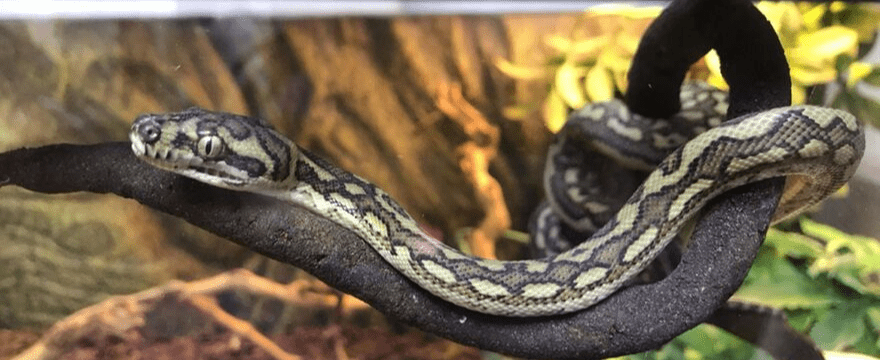Just got yourself a new pet? Find out below, everything you need to know on how to care, house and maintain a healthy, happy Carpet Python.
Housing:
Carpet Pythons require a wooden vivarium as their enclosure. This is because wood is an excellent insulator of heat and so a wooden vivarium will make it easier to control the crucial temperature required inside the habitat. Other enclosures such as glass terrariums are far too efficient at releasing heat. The wooden vivarium should have good ventilation to allow air flow in and out of the enclosure.
The carpet python’s vivarium should be at least 3000mm (24″) in length and 900mm (36″) in height. There are 2 main reasons for this; firstly, carpet pythons are not small reptiles and can easily grow to 1500mm in length. They require a proportionate amount of space to live happily. Secondly, the vivarium needs to have enough length to allow for the creation of a temperature gradient. The enclosure needs to be warm at one end but has enough distance for the temperature to drop at the cool end.
Heating:
Carpet Pythons require a warm basking area but a near-constant air temperature. A basking area of 31°C and cool end of around 29.4°C. This is to be created using a ceramic night bulb.
These radiate heat but produce no light. This bulb should be protected with a bulb guard and controlled by a good quality thermostat. this temperature can remain constant day and night. Temperatures should be monitored daily using a thermometer. To light the enclosure we would use LED bulbs that do not radiate much heat or light. These can be on for 10-12 hours a day and should be turned off at night to ensure that the snake gets a good day/night cycle.
Decoration:
Carpet Pythons should be kept on a dry substrate to increase the humidity inside the vivarium. Whilst any loose substrate has the potential to be accidentally swallowed, we have found this to not be a problem with cocotube wood chip bark.
Carpet Pythons are arboreal snakes so they do like to climb on top of things to survey their surroundings. The vivarium should be decorated with various pieces of wood to enable them to do this.
The Carpet Python vivarium can be decorated with artificial plants for a more natural look. A hiding spot at each end of the enclosure will allow the snake to move freely and thermoregulate while feeling secure.
Feeding:
As hatchlings, carpet pythons should be fed weekly on defrosted pinky mice, as the snake grows the food size should be increased. Adult Carpet Pythons can be fed once every two weeks as they can become overweight if fed weekly.
A water bowl large enough for the snake to get in to should be provided on the cool end of the enclosure.
With any questions about the care of a Carpet Python, message our team on Facebook.




